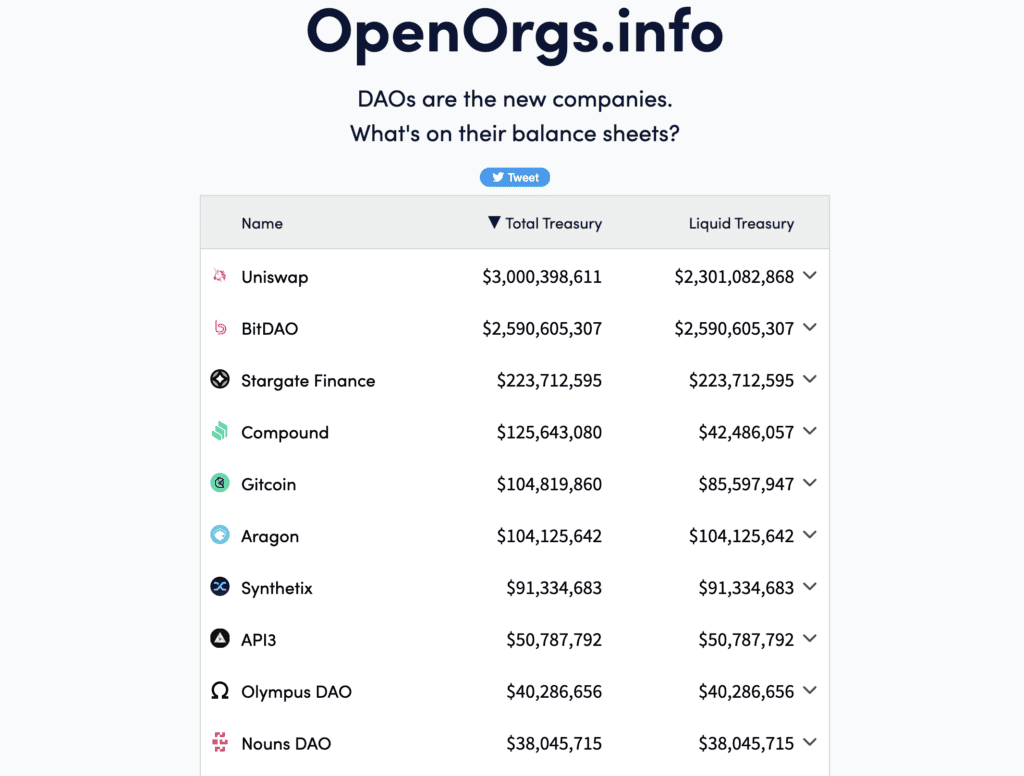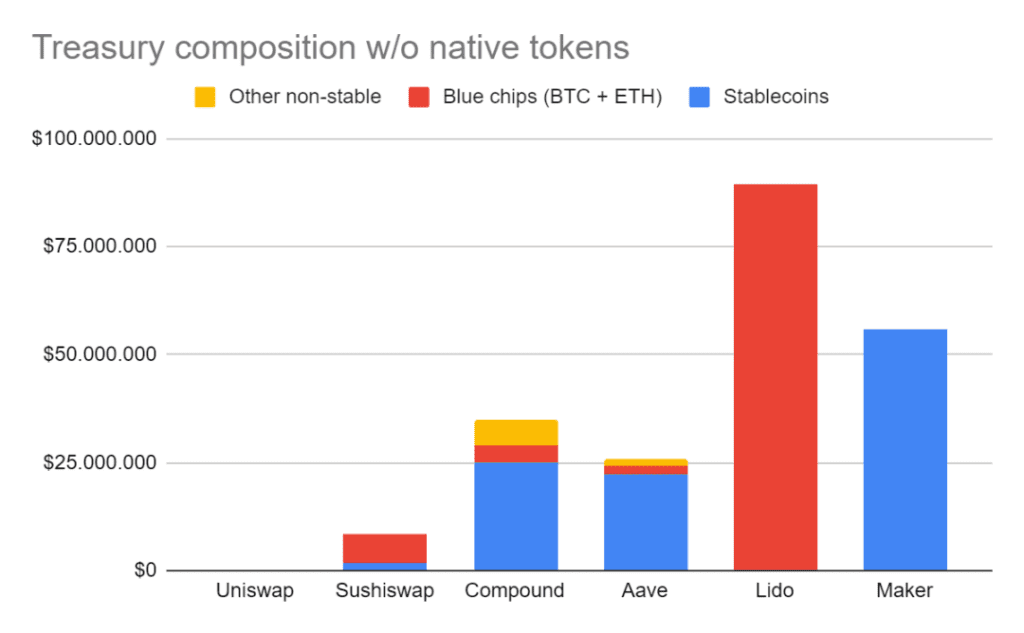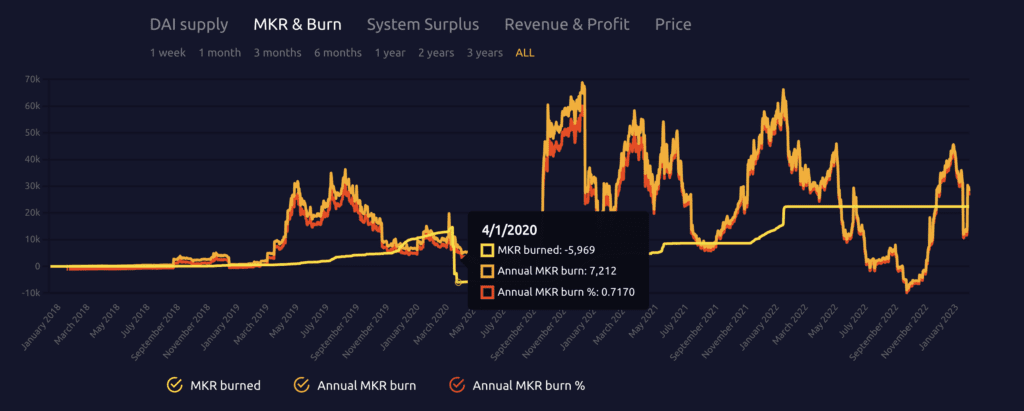In the summer of 2020, the bull market on the DeFi track started by COMP liquidity mining turned many DeFi protocols into fast-growing revenue “monsters.” One might assume that these projects are in good financial shape, and a cursory look at the various DAO treasuries seems to confirm this view. For example, OpenOrgs.info pointed out that the assets of top DeFi protocols can reach hundreds of millions of dollars, while projects like Uniswap even reach billions of dollars.

However, most of the funds in the treasury of these projects are the native tokens of the projects, such as UNI, COMP, and LDO, as shown in the table below:

Native tokens can, of course, be used as funds. But counting it as an asset does more harm than good and is often used as an excuse for poor money management.
To illustrate this point, let’s take a brief look at traditional accounting.
Native tokens are not assets
Although the law does not regard the native tokens of the DeFi protocol as equity, we can still start with the attitude of traditional companies to their equity. In simple terms, a company’s outstanding shares consist of outstanding shares (all publicly traded shares) and restricted shares (employee incentive options that are cashing out).
The issued shares are part of the rated share capital – a self-imposed soft cap on the number of shares issued. The most critical point is that unissued shares approved by the company’s articles of association are not included in the company’s balance sheet. How could it be counted? Putting unissued stock on its balance sheet allows companies to issue shares at will — and without selling them — to add to their assets.
You can see the connection between this and the native tokens in the DAO treasury: these tokens are equivalent to approved but unissued shares. They are not assets of the individual protocols, but simply represent the total number of tokens that the DAO can “legally” issue and sell to the market.
In this way, the number of native tokens approved by the DAO to issue and enter the vault is meaningless: these tokens do not represent real purchasing power. For an example, let’s say Uniswap wants to sell 2% of the funds in the vault (the native token). If this transaction were executed on 1inch, sending the order to numerous on-chain and off-chain markets, the price of UNI would drop by nearly 80% as a result.
Real DeFi vaults
Ignoring approved but unissued shares, we can see a different and more accurate picture of DeFi vaults. Here, we further subdivide non-native tokens into three categories: stablecoins, blue-chip cryptocurrencies, and other non-stable cryptocurrencies. According to this standard, the assets of Uniswap are approximately equal to 0, and only Lido and Maker have assets of more than $50 million.

But why would a vault with so many assets have problems?
We have learned earlier that it is not enough to just issue new native tokens, and they have to be sold in the market, which will affect the price and restrict mass sales. In addition, the price of native tokens in the market is not stable and fluctuates violently.
Second, the price depends on the overall market situation. The cryptocurrency market has gone through several speculative cycles. Many tokens have reached fantastic valuations, and they have also experienced times when they plummeted by 90% and recovered weakly.
Third, when DeFi projects urgently need funds, they often magnify the risks unique to the project itself. For example, when a project becomes severely insolvent due to a bug or hack, but hopes to fully compensate users, the token price will also often plummet – especially if holders believe that the project will issue further tokens.
Case study: Black Thursday exposes MakerDAO’s problems
The risk of insufficient funds in the treasury does not just stay on paper. On March 12, 2020, during the “Black Thursday” crash in the currency circle, MakerDAO had first-hand experience of this. The lack of liquid assets has caused MakerDAO’s credit to almost collapse, and even if the crisis is finally resolved, the assets of token holders have shrunk sharply. Let’s recap:
Since its launch in 2018 until March 2020, MakerDAO has been using net proceeds to repurchase and destroy MKR tokens (returning capital proceeds to token holders). They destroyed a total of 14,600 MKR at the cost of more than 7 million DAI. During this period, the MKR token averaged around $500.
Then Black Thursday came, and due to the price crash and the congestion of the Ethereum network, MakerDAO failed to liquidate the underwater position in time and suffered a loss of $6 million. At that time, the MakerDAO vault only had 500,000 DAI, and they had to sell MKR on the market to cover the remaining 5.5 million losses. MakerDAO ended up selling 20,600 MKR at an average price of about $275.
It was not until December 2020 that MakerDAO returned the supply of MKR to the original 1 million by using accumulated proceeds to buy back tokens. During this process, the average price of MKR was $500, and the total cost exceeded 3 million DAI.

The financial impact of this incident on MakerDAO is the $6 million credit loss on Black Thursday, which wiped out all the $10 million in earnings accumulated over the past three years. If MakerDAO held more stable assets such as DAI, it could save $4 million in losses because the funds could be used to repay the losses without having to sell MKR at a low price. Or in other words, MakerDAO could have even gained an additional $4 million in value with a little more treasury reserves.
While it is difficult to assess funding needs ahead of time, the 500,000 DAI held by MakerDAO as of Black Thursday is certainly too little. The Maker agreement has 140 million outstanding debts, and the 500,000 DAI can only repay 0.35%, while most traditional financial institutions must hold at least 3-4% of liabilities in risk reserves. This will also deduct operating costs and employee salaries. If there are no non-native tokens in the treasury to cover this part of the cost, then in a bear market, the protocol may be further forced to sell native tokens.
Understanding buybacks and yields
Many DeFi projects naively treat native tokens as treasury assets and even have to sell these assets at the worst time because of the lack of a more feasible framework. While there are various ways to run a protocol, the following points should greatly benefit practitioners.
Article 1:
The goal of the DAO is to maximize the value of long-term token holders.
Article 2:
In practice, the former will invest every bit of assets held or acquired by the agreement in the most profitable direction and convert its current value accordingly. Viable options include depositing funds in the treasury, reinvesting them in growth or new products, or distributing them to token holders through token buybacks or dividends.
The funds should only be paid out directly rather than saved or reinvested if, outside of the agreement, the holder earns a higher after-tax return. The reality is that many DeFi protocols pay out funds that could have been used to grow or stored in vaults. According to the framework discussed above, this is a very serious mistake. In the case of MakerDAO, we’ve seen how the protocol traded cash for tokens, which they then had to buy back at a much higher cost.
In general, you must not think that paying dividends or buying back tokens is rewarding token holders, but the internal investment is not. The most beneficial decision for token holders is to maximize the return on all funds, whether internal or external.
Article 3:
When the above rules are followed, the DAO will become a trader outside the native token ecosystem. If the DAO believes that the native token is overvalued and there is a good return on internal reinvestment, the token should be sold for cash to be reinvested in the protocol. This is the case during almost all bull markets. If the DAO sees that the price of its tokens is lower than the fair value and holds idle funds, and there is no high return channel internally, it can buy back tokens. This is the case in almost all bear markets.

Improved treasury management
Finally, we would like to share a few thoughts on DAO treasury management. We came up with the following rules:
Article 4:
The DAO should immediately discount the native tokens in the vault. Native tokens are the cryptocurrency version of unissued shares.
Article 5:
The DAO treasury is getting ready for the next bear market. The next bear market isn’t necessarily next week or next month, or even next year. But in a market driven by speculation like cryptocurrencies, sooner or later, a bear market will come. Your vault needs to be able to last 2-4 years when the entire market crashes by 90% and stays there for a long time.
The number of 2-4 years can ensure that you can survive the longest bear market in recorded history without saving too much money, making people lazy, or turning the project into a hedge fund, which deviates from the original intention.
At present, large-scale DAOs with their own large development teams and liquidity mining projects have high operating expenses, and few of them meet this requirement. This means that most DAOs, if not all DAOs, should take advantage of the bull market to sell tokens and fill their coffers with stable assets, which will not only survive the next bear market but also potentially stay ahead of their competitors.
Article 6:
DAO treasuries should be aware of their inherent weaknesses and hedge against them. For example, credit markets prepare for a portion of bad debt each year. While no one said it, everyone knew that the credit markets had priced in this risk. This part of the risk becomes a regular cost and can be hedged. At the same time, a more streamlined protocol like Uniswap may not calculate the additional risk, so a smaller reserve of funds is fine.
DISCLAIMER: The Information on this website is provided as general market commentary and does not constitute investment advice. We encourage you to do your own research before investing.
Join us to keep track of news: https://linktr.ee/coincu
Harold
Coincu News














